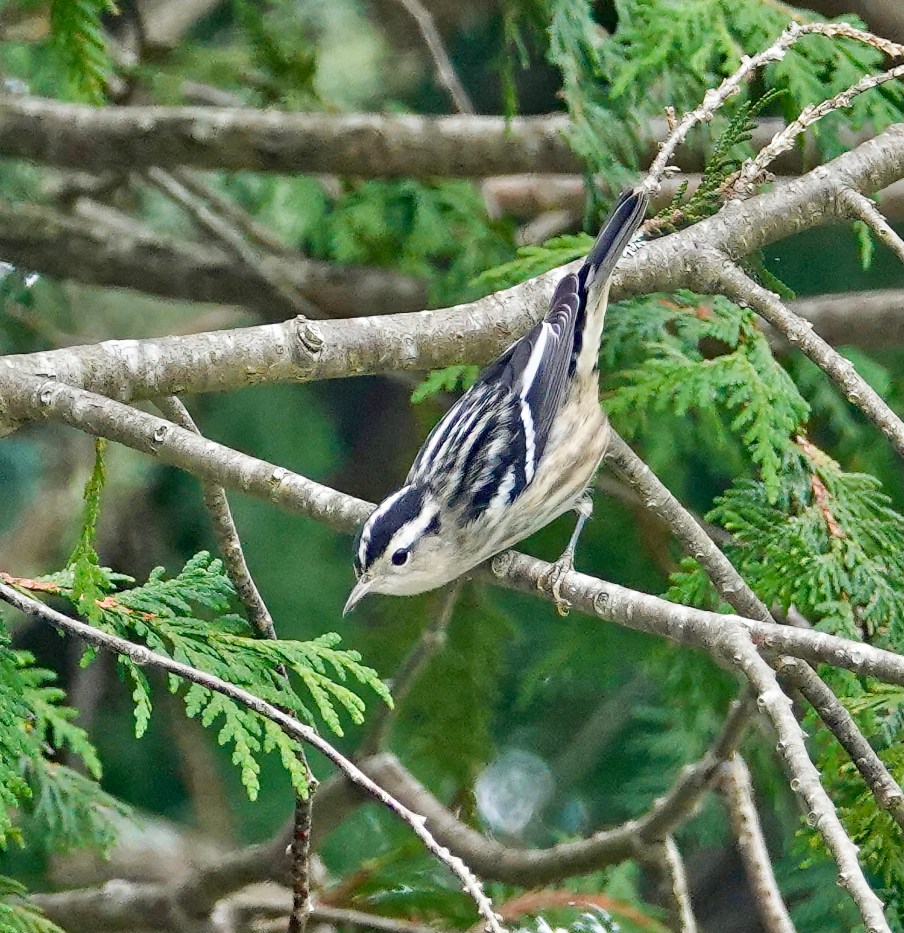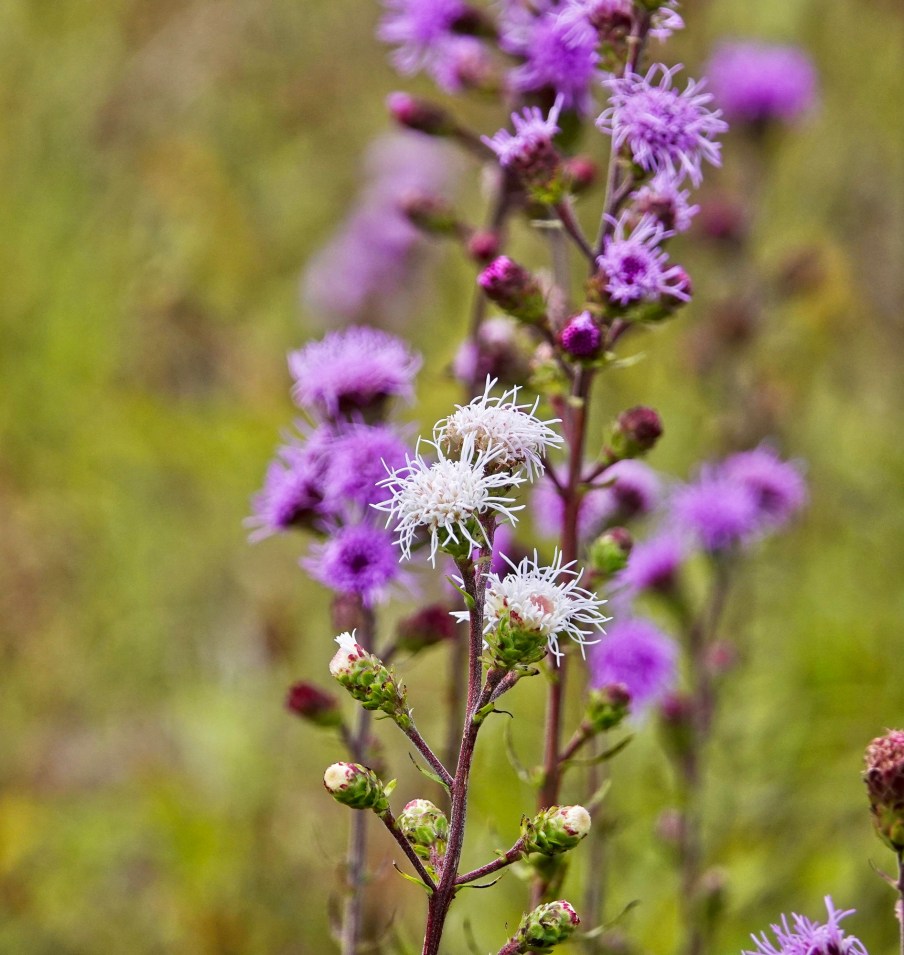Eagle, Eagle!

Bald Eagle, Muskrat Pond, Medomak, Maine, USA — This American Bald Eagle was really too far away for photos…but what are you going to do? It was all the way across Muskrat Pond in Medomak, Maine, at least a quarter of a mile, when I visited with the Holbrook Travel group at Hog Island Audubon Camp last this week. Sony Rx10iv at 600mm equivalent…but cropped, upscaled, and recropped for maybe the equivalent of 2000mm. Lots of mist in the air too, and crummy light, which did not help either. Still, we do what we have to. 🙂 Program mode with my custom birds and wildlife modifications. Processed in Polarr, upscaled in Pixomatic Pro, finished in Apple Photos. ISO 250, 500, and 400 @ f4 @ 1/500th.
Black and White

Black and White Warbler: Medomak, Maine, USA — As part of my day with the Holbrook Travel group at Hog Island Audubon Camp, we took a walk around Muscrat Pond in Medomak, a small village just up the coast from Hog Island. There were birds. Not a great many, but more than a few species…not easy to photograph as they foraged in hedgerows and tree tops…typical Maine August birding when the migration is just getting under way. Just that much north of us they do have many nesting warblers that we don’t see all summer here in Southern Maine, like this female Black and White Warbler, who did come out to the edge of the foliage for a few moments while we watched. Sony Rx10iv at 600mm equivalent. Program mode with my custom birds and wildlife modifications. Processed in Polarr, enlarged in Pixelmator Pro and cropped for scale, and finished in Apple Photos. ISO 500 @ f4 @ 1/500th.
Sundew!
Sundew, Hidden Valley Nature Center, Jefferson, Maine, USA — As promised, we are here today to celebrate Sundew! Sundew is another carnivorous bog plant. Instead of drowning its prey, as the Pitcher Plant from yesterday does, the Sundew has little sticky spikes on open pads that attract insects. The insects get stuck and the nutrients are absorbed. You can see a couple in the shots here. A tiny back beetle, and small green caterpillar of some sort. Sundew is hard to see, even in a bog full of it. The little sticky, spiky, pads are often all that rises above the level of sphagnum moss, though the first shot above shows more of the plant, and those pads are less than 1/4 inch across. In good light you look for the glitter of the crown of tiny sticky beads of gue on the tips of the spine. And then you get in really close for a photo. The shot that shows more of the plant was taken at 600mm with my Sony Rx10iv from about 3 feet (and that was an exceptionally large plant), but the other two are from my iPhone SE with the Sirui 10x macro lens attached. I had to get down on my knees and elbows and bend over the edge of the floating platform, to get the phone within about 1/4 inch of the plants for those shots. Then I had to get back up…not easy at my age. The things we do. 🙂 Still, I would do it again, just for the privilege of seeing and celebrating the strange and wonderful carnivorous, bog dwelling, Sundew plant!
Pitcher Plant
Hidden Valley Nature Center, Jefferson, Maine, USA — I spent the day with the Holbrook Travel group at Hog Island Audubon Camp yesterday, and presented an afternoon workshop on nature photography. One of the highlights was a visit to the bog platform at Hidden Valley Nature Center in Jefferson. I have never seen a better display of Pitcher Plant. (We also found lots of Sundew plants, which I will feature in another post.) Pitcher Plant is a carnivorous plant. Insects are attracted to the water in the pitcher and then, because of the structure of the plant, can not climb back out. They are digested in the pitcher and the nutrients feed the plant. They have a strange flower that is mostly bract. We have them in the remnant bogs in Southern Maine, but nothing like the display at Hidden Valley…just that much further north. Photos with the Sony Rx10iv at various focal lengths for effective framing. Program mode with my custom birds and wildlife modifications. Processed in Polarr and Apple Photos.
Spotted Spreadwing

Spotted Spreadwing: SMHC drainage ponds, Kennebunk, Maine, USA — Though we seemed to get off to a slow start, it has turned out to be a pretty good summer for Odonata. The little drainage pond at the end of the Southern Maine Health Care parking lot is always productive. There were quite a few Spotted Spreadwings in mating wheels around the pond and I managed to get shots of a few. Nikon B700 at 1440mm equivalent. Program mode with some birds and wildlife tweaks. Processed in Polarr and Apple Photos. ISO 100 @ f6.5 @ 1/125th. -.3 EV.
Monarchs in Blazing Star

Monarchs and Northern Blazing Star, Laudholm Farms, Wells, Maine, USA — I stopped by the National Estuarine Research Reserve at Laudholm Farms the other day while out on my eTrike. The staff have planted a native species garden near the entry kiosk and they have a few Northern Blazing Star plants which are exceptionally tall and full, probably because they get watered every day. They are attracting Monarchs. (They also have a field of Milkweed down below the farm buildings so they are working both ends of the Monarch cycle 🙂 Because there was only the one stand of Blazing Star there was a lot of interaction between the Monarchs…that swirling chase they do…and they were often on two sides of the same plant…making for a great photo op. Nikon B700 at ~ 1125mm equivalent. Program mode with some custom tweaks for birds and wildlife. Processed in Polarr and Apple Photos. ISO 100 @ f5.6 @ 1/250th.
Widow Skimmer with sparkles :)

Widow Skimmer: SMMC drainage pond, Kennebunk, Maine, USA — Sometimes it is as much about the setting as it is the dragonfly. This Widow Skimmer was guarding its perch from a Slaty Skimmer, which wanted to take it over. The sparkles off the water behind make for a striking photo. I think. Nikon B700. Program at 1440mm equivalent and ISO 100 @ f6.5 @ 1/320th with -.3 EV exposure compensation. Processed in Polarr and Apple Photos.
White Blazing Star

Northern Blazing Star: Kennebunk Plains Preserve, Kennebunk, Maine, USA — I tried to look it up, but I can find no information (in a casual search) on what percentage of Northern Blazing Star flowers are white…but from my experience it can’t be very high. Among perhaps a hundred thousand blossoms on the Kennebunk Plains in August, I have seen 3 plants with white flowers, for a total of less than a dozen flowers. So these white flowers are a rarity even for an already rare plant like Blazing Star. Sony Rx10iv at 600mm equivalent. Program mode with my custom birds and wildlife modifications. Processed in Polarr and Apple Photos. ISO 100 @ f4 @ 1/800th.
Groundnut

Groundnut or Potato Bean (Apios americana): Emmon’s Preserve, Kennebunkport, Maine, USA — This is a new plant for me, at 74 years of age, so either I have not gotten out enough (not true), or there are still things for me to discover even at my age. It is not a particularly rare plant either…just one that I have not come across. It is a vine and produces, as you might guess from the common names (and “Indian Potato” is another, if less culturally sensitive, common name for Apios americana) both edible beans and a large edible tuber. It is native to North American, and historically it was a stable of Indigenous American diets from New England to Florida and west to the Rockies. It is currently cultivated and an important food source in certain regions of Japan, and its medicinal and nutritional benefits have been extensively researched and promoted there. There is an comprehensive and well referenced wikipedia article on the plant if you want more info…but suffice it to say that it is generally recognized to very good for you, better than a potato in many unique curative ways 🙂 It is not cultivated outside Japan largely because it takes two years for the tuber to develop…which means you can get two crops of potatoes for every one crop of groundnuts. The flowers are quite striking…one theory is that it was introduced to Japan as an ornamental. The plants I saw at Emmon’s Preserve appear to be growing wild, on either side of a busy trail at the edge of a big meadow. I have walked that trail hundreds of times, but only saw the plants last week, probably because they were in flower. Sony Rx10iv at 600mm equivalent. Program mode with my custom birds and wildlife modifications. Processed in Polarr and Apple Photos. ISO 800 @ f4 @ 1/500th.
Wood Nympth on Blazing Star

Wood Nympth on Northern Blazing Star, Kennebunk Plains Preserve, Kennebunk, Maine, USA — By far the most numerous butterfly on the Kennebunk Plains during August and Northern Blazing Star season is the Wood Nympth…but then the Wood Nympth is probably the most numerous butterfly in southern Maine all summer. They come out early in spring and are present well into fall, and always in good numbers. This year, as in most creatures in southern Maine, seems to be bumper year. There were hundreds of them in the Blazing Star. They are not the most attractive of butterflies, but it appears to be working for them. Sony Rx10iv at 600mm equivalent. Program mode with my custom birds and wildlife modifications. Processed in Polarr and Apple Photos. ISO 100 @ f4 @ 1/500th.






